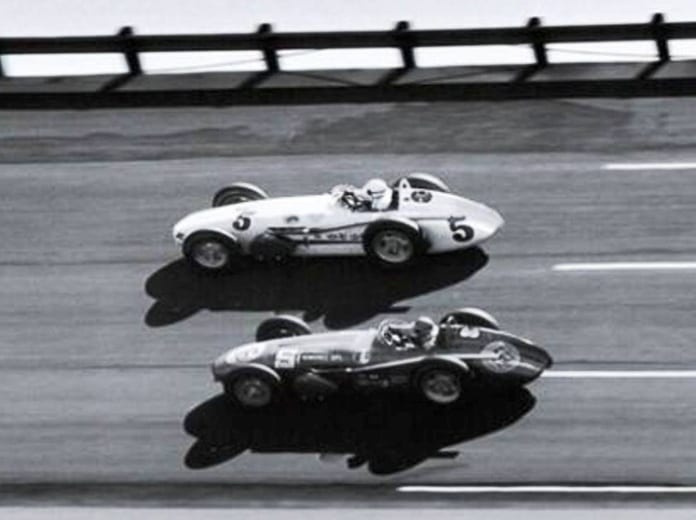Sixty years ago, the prestige of Indy car racing was such that Bill France turned to the division to christen his dream track — Daytona Int’l Speedway.
The open-wheel machines offered exactly what France was peddling with his 2.5-mile, high-banked marvel: blood-boiling excitement, exotic, compelling looks and uncanny speed.
He’d already scheduled an Indy car race for April 4, 1959, and a 250-mile race for July 4. Then, two weeks before the first Daytona 500, he recruited former Hudson Hornet NASCAR ace turned Indy car driver Marshall Teague to make a series of high-speed runs.
Driving Chapman Root’s streamlined Kurtis Kraft Indianapolis roadster, Teague was to go after the world closed-course speed record. His initial runs seemed promising with laps of more than 170 mph. Then, on Feb. 11, he spun in turn two.
The 170-mph windstream lifted the car and launched it into a series of vicious flips that flung Teague through the cockpit canopy and several hundred feet down the track. He died instantly.
Although Indy cars raced in 1957 and ’58 at Italy’s Monza Circuit, a similarly daunting, high-speed track, without problem, Teague’s death triggered an ominous cry of opposition against racing at Daytona Int’l Speedway.
To cautiously acclimate teams to the unique tri-oval in preparation for the longer July race, USAC scheduled the April event as double 100-milers. The first was a points-paying national championship run and the second was a non-points FIA Formula Libre race.
Practice and qualifying stretched through the week before race day, generating headline-grabbing speeds as drivers pushed toward the 180-mph mark.
Other than a couple of spins, there was only one violent incident. Bob Veith lost control in a gust of wind on the backstretch. He escaped the horrific crash with only minor injuries, although his Cromwell helmet was ground down to the inner webbing.

“I didn’t think it was ever going to stop sliding,” Veith quipped.
He credited his car’s roll bar, required by USAC after Pat O’Connor’s death at Indianapolis in 1958, with sparing his life.
Speeds slowed only slightly for qualifying. Dick Rathmann, in the No. 41 Sumar Special, captured the pole at 173.689 mph. His brother Jim lined up next to him.
On the second day of qualifying, George Amick went even faster. Driving George Bignotti’s Epperly roadster, Amick dazzled observers with a 176.88-mph run. In comparison, the Daytona 500 pole speed was 140 mph, while 145 mph claimed the pole at Indianapolis.
The Rathmann brothers led 18 other drivers, including A.J. Foyt, Roger Ward, Pat Flaherty, Tony Bettenhausen and Eddie Sachs to the green flag before a sparse crowd, estimated at fewer than 10,000 fans.
Despite the pre-race concerns for high-speed mayhem, only Dempsey Wilson spun on lap 28. Jim Rathmann flashed under the checkered flag at an average speed of 170.261 mph, but trouble lurked behind him.
Moments behind Rathmann, Amick attempted to dive under Bob Christie for third. The quick, high-speed maneuver and possibly dirty air caused him to lose control. The car turned up the banking, impacted the guardrail and broke apart. What remained of the car rolled a dozen times, throwing a storm of debris.
Bill Cheesbourg spun to avoid the mess, leaped from his car and ran to Amick’s aid. Looking into the car he realized aid was useless. The little driver with the enormous potential was gone.
Because of the lengthy cleanup, it required nearly two hours to repair the guardrail, the Formula Libre race was shortened to 50 miles. Jim Rathmann won that one too, at a comparatively moderate 160.694 mph.
That afternoon the boys from the Midwest loaded their low-slung roadsters under a pall and quietly left Daytona Beach, Fla. USAC canceled the July 4 race and NASCAR replaced it with a Grand National race that evolved into the Firecracker 400.
